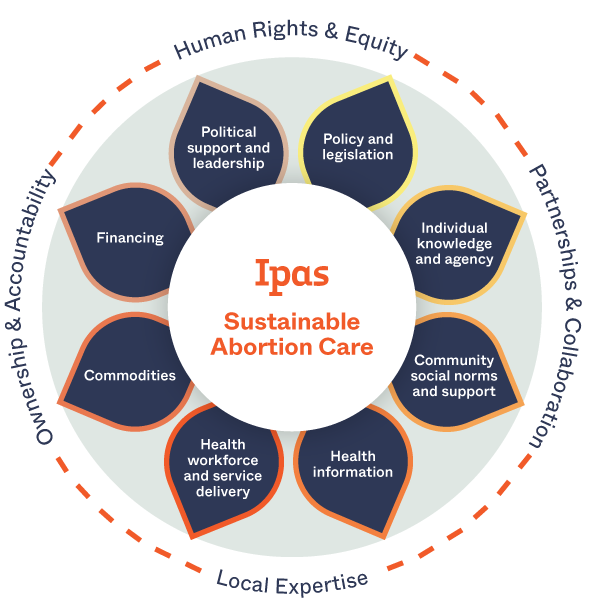Search Results
Available Here Search Results The middle ground between traditional philanthropic and commercial spaces is a continuum; we need to shift the dialogue from morals to tools.
Available Here Search Results Regardless of the disease or health issue in question, stigma functions in much the same way. Abortion stigma shames and silences women seeking abortions and providers, and is a major contributor to unsafe and often lethal …
Available Here Search Results Sexual orientation, gender identity, intimate partnerships and reproduction are fundamental components of our human lives. They form inextricable linkages between the LGBTQ and abortion rights movements, and yet we do not …
This study examined contraceptive use and dual protection in the postpartum period in a Prevention of Mother to Child Transmission (PMTCT) population and whether it varied by HIV status. Pregnant participants were recruited from a government clinic in an urban township and the analytic sample was 821.
This study assesed the severity of abortion complications in Malawi and determined associated risk factors. Between July 20 and September 13, 2009, a cross-sectional survey was conducted at 166 facilities providing postabortion care services.
Certainly, sharing abortion stories can be a powerful act and may reduce self-stigma. But I fear that it distracts from the structural inequalities of race, poverty, age, and education by placing too much emphasis on the individual. And I worry that it lets our politicians and policymakers off the hook.
Guidance for postabortion care (PAC) is established for the first trimester but limited in the second trimester. Objective: To establish evidence-based recommendations for PAC in the second trimester. Conclusion: Misoprostol with or without mifepristone is an effective treatment for second-trimester PAC. The minimum misoprostol dose is 200 μg vaginally, sublingually, or buccally every 6–12 hours.
A comprehensive structured program design, collaboration between the MOH and Ipas, and provider dedication enabled successful introduction of second-trimester abortion services in major regions/states of Ethiopia. A focus on second- trimester medical abortion allows for rapid service introduction without extensive changes to facilities, equipment, or staffing as the needs are similar to obstetric care.
Background: the grounds for the legal termination of pregnancy in the Mexican Republic vary according to the provisions of the Constitution of each state; as of 2007 it is legal in Mexico City. Objective: to identify the knowledge, attitudes and practice of abortion among gynecologists and obstetricians. Conclusions: it is necessary to increase and improve technical and legal knowledge about abortion, especially among OB / GYNs, who are responsible for complying with what the law indicates, in accordance with international recommendations and the exercise of the reproductive rights of the woman.
Search Results Although Cambodia now permits elective abortion, scarcity of research on this topic means that information on abortion incidence is limited to regional estimates. This estimation model combines national survey data from Demographic and H …
The African Commission on Human and Peoples’ Rights recently adopted General Comment No 2 to interpret provisions of Article 14 of the Protocol to the African Charter on the Rights Women.
This study describes postabortion complication severity and associated factors in Kenya. A nationally representative sample of 326 health facilities was included in the survey. Data were collected from 2,625 women presenting with abortion complications.
In order to narrow the gap between the promise and realization of African women’s right to reproductive health care, the African Commission on Human and Peoples’ Rights adopted General Comment No. 2 last year, releasing it online earlier this month. The document was drafted under the guidance of Commissioner Soyata Maiga, Special Rapporteur on the Rights of Women in Africa, with technical support from the Ipas Africa Alliance and input from numerous reproductive rights and legal experts throughout the region.
Despite liberalization of the Nepal abortion law, young women continue to experience barriers to safe abortion services. This study evaluated differences in reproductive knowledge and attitudes by marital status. Participants were surveyed on demographics, romantic experiences, media habits, reproductive information, and abortion knowledge and attitudes. Only 45% responded that they knew that abortion was legal, and fewer ever-married women were aware of abortion legality. Never-married women expected more negative responses from having an abortion than ever-married women. Findings highlight the need for providing sexual and reproductive health care information and services to young women regardless of marital status.
The primary study aim was to describe patient satisfaction regarding abortion experiences in urban academic family medicine centers (FMCs). We conducted a cross-sectional survey of 210 women obtaining a first trimester medication or aspiration abortion at four FMCs. The majority of women (93%) were very satisfied with their abortion experience in their FMC, regardless of clinical site or abortion method. Women most commonly cited positive interactions with the staff and physicians as the best part of their experience. This study demonstrates that women who receive abortion services at academic FMCs are highly satisfied with their care.
Maternal mortality in Sierra Leone is one of the highest in the world and complications from unsafe abortion are one of the leading causes. This article reports the results of a 2012 study to assess the impact and costs of treatment of abortion complications on the country’s public health system, and estimate the costs of a shift to safe, legal abortion. The study concludesdthat a shift to safe, legal abortion would dramatically reduce the current costs of PAC.
CONTEXT: Abortion is legally restricted in Malawi, and no data are available on the incidence of the procedure. METHODS: The Abortion Incidence Complications Methodology was used to estimate levels of induced abortion in Malawi in 2009. Data on provision of postabortion care were collected from 166 public, nongovernmental and private health facilities, and estimates of the likelihood that women who have abortions experience complications and seek care were obtained from 56 key informants.
This report documents findings from a recent nationwide study of the incidence of induced abortion and severity of complications of unsafe abortion in Kenya. The study was conducted in 2012 among a nationally representative sample of Levels II to VI public and private health facilities. The Abortion Incidence Complications Methodology (AICM) and the Prospective Morbidity Methodology (PMM) were used as well-established and complementary approaches to estimate abortion incidence and the severity of unsafe abortion complications in Kenya.
Search Results Resultados. En 2012, 31.2% de las adolescentes (15-19 años) había iniciado vida sexual; el uso del condón aumentó de 31.8 a 47.8% entre 2006 y 2012. El 47.9% de 30 a 34 años y 53.2% de 35 a 49 años reportaron no haber usado anticonceptiv …
Search Results Conclusión. En México no existe correlación entre la elevada atención del parto en unidades médicas y la RMM, por lo que no sólo es necesario garantizar la atención universal del parto por un profesional de la salud sino que ésta la debe …

